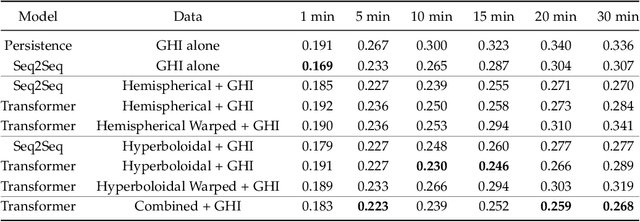Leron Julian
Precise Forecasting of Sky Images Using Spatial Warping
Sep 18, 2024



Abstract:The intermittency of solar power, due to occlusion from cloud cover, is one of the key factors inhibiting its widespread use in both commercial and residential settings. Hence, real-time forecasting of solar irradiance for grid-connected photovoltaic systems is necessary to schedule and allocate resources across the grid. Ground-based imagers that capture wide field-of-view images of the sky are commonly used to monitor cloud movement around a particular site in an effort to forecast solar irradiance. However, these wide FOV imagers capture a distorted image of sky image, where regions near the horizon are heavily compressed. This hinders the ability to precisely predict cloud motion near the horizon which especially affects prediction over longer time horizons. In this work, we combat the aforementioned constraint by introducing a deep learning method to predict a future sky image frame with higher resolution than previous methods. Our main contribution is to derive an optimal warping method to counter the adverse affects of clouds at the horizon, and learn a framework for future sky image prediction which better determines cloud evolution for longer time horizons.
Computational Imaging for Long-Term Prediction of Solar Irradiance
Sep 18, 2024



Abstract:The occlusion of the sun by clouds is one of the primary sources of uncertainties in solar power generation, and is a factor that affects the wide-spread use of solar power as a primary energy source. Real-time forecasting of cloud movement and, as a result, solar irradiance is necessary to schedule and allocate energy across grid-connected photovoltaic systems. Previous works monitored cloud movement using wide-angle field of view imagery of the sky. However, such images have poor resolution for clouds that appear near the horizon, which reduces their effectiveness for long term prediction of solar occlusion. Specifically, to be able to predict occlusion of the sun over long time periods, clouds that are near the horizon need to be detected, and their velocities estimated precisely. To enable such a system, we design and deploy a catadioptric system that delivers wide-angle imagery with uniform spatial resolution of the sky over its field of view. To enable prediction over a longer time horizon, we design an algorithm that uses carefully selected spatio-temporal slices of the imagery using estimated wind direction and velocity as inputs. Using ray-tracing simulations as well as a real testbed deployed outdoors, we show that the system is capable of predicting solar occlusion as well as irradiance for tens of minutes in the future, which is an order of magnitude improvement over prior work.
 Add to Chrome
Add to Chrome Add to Firefox
Add to Firefox Add to Edge
Add to Edge